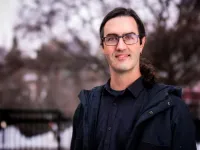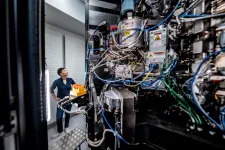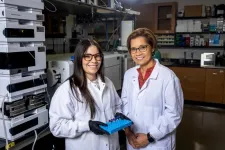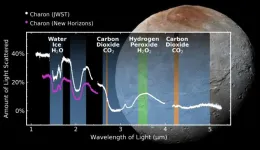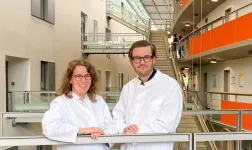(Press-News.org) A new survey of climate experts reveals that a majority believes the Earth to be headed for a rise in global temperatures far higher than the 2015 Paris Agreement targets of 1.5 to well-below 2°C.
The study was published in the Nature journal Communications Earth & Environment. It also shows that two-thirds of respondents — all of them authors on the Intergovernmental Panel on Climate Change (IPCC) — believe we may succeed in achieving net zero CO2 emissions during the second half of this century. This indicates some optimism that mitigation efforts may be starting to bend the emissions curve toward what would be needed to achieve the Paris temperature goal.
A majority also acknowledged the potential for atmospheric CO2 removal, with a median response indicating a belief that the technology could remove up to five gigatons of carbon dioxide (GtCO2) a year by 2050. That is at the lower end of the range believed to be necessary to meet the Paris targets.
“We wanted to survey some of the top climate experts in the world to get some insight into their perceptions of different future climate outcomes,” says the paper’s lead author, Seth Wynes, a former postdoctoral fellow at Concordia, now an assistant professor at the University of Waterloo.
“These scientists also engage in important climate change communication, so their optimism or pessimism can affect how decision-makers are receiving messages about climate change.”
More is needed to avert catastrophe
The 211 respondents to the survey were generally pessimistic about reaching the Paris targets given current policies, with 86 per cent estimating warming above 2˚C by 2100. The median estimate was 2.7˚C, which is expected to have catastrophic consequences for the planet.
Co-author Damon Matthews, a professor in the Department of Geography, Planning and Environment, notes that this does not mean that level of warming is inevitable.
“These responses are not a prediction of future warming, but rather a gauge of what the scientific community believes. The answers are surprisingly consistent with previous estimates of what would happen if our current climate policies continued without any increase in ambition, which range from about 2.5 to 3˚C.”
Along with questions about the likelihood of future climate outcomes, the respondents were also asked to estimate their peers’ responses to the same questions.
“There was a strong correlation between what people believe and what they sense their peers believe,” Wynes says. “They had a bias to see their beliefs as representative of the larger group. This can indicate an overconfidence in their own beliefs, so we think this is a good opportunity for them to reevaluate what their peers actually believe.”
Working with data, not policy
An IPCC author himself, Matthews admits that scientists’ views on possible climate scenarios are valuable, but other perspectives on the issues around climate change are necessary if we hope to slow it.
“Climate scientists certainly have expertise in climate systems and energy transitions, but it will be policy implementation and societal change that actually determine how quickly emissions drop,” he says.
“Ultimately, the decision as to what we do and how we respond to the climate challenge is up to policymakers and the public that they represent, and I think the full range of outcomes is still very much on the table.”
Contributing authors to this paper include Steven Davis of Stanford University, PhD candidate Mitchell Dickau and MSc student Susan Ly at Concordia University, Edward Maibach at George Mason University, Joeri Rogelj at Imperial College, London and Kirsten Zickfeld at Simon Fraser University.
Read the cited paper: “Perceptions of carbon dioxide emission reductions and future warming among climate experts.
END
Climate scientists express their views on possible future climate scenarios in a new study
Paris targets are far out of reach without more sustained action, most believe
2024-10-01
ELSE PRESS RELEASES FROM THIS DATE:
Anu wins first place, $20,000 in SCORE’s 60th Anniversary Pitch Competition
2024-10-01
WEST LAFAYETTE, Ind. — Anu™, a health and wellness brand developing innovative controlled-environment agriculture systems, won first place and $20,000 among 10 small businesses at the national SCORE 60th Anniversary Pitch Competition in Des Moines, Iowa. SCORE, or Service Corps of Retired Executives, is a resource partner of the U.S. Small Business Administration.
Purdue University alumni Scott Massey and Ivan Ball founded anu. The company has received financial support from the Purdue Research Foundation.
“This funding ...
NSF funds project to examine social, environmental impacts of AI
2024-10-01
As artificial intelligence continues to expand its footprint across society, some researchers are raising questions about the potential negative impact of this technological transformation.
Associate professor Mar Hicks and assistant professor Jess Reia of the University of Virginia’s School of Data Science are partnering with Tamara Kneese and the Data and Society Research Institute to examine this critical issue in a project that the National Science Foundation recently awarded a two-year, $300,000 grant.
Working with the Data ...
New study: neuroscientists spark shelter-seeking response by reactivating memory circuit
2024-10-01
FOR IMMEDIATE RELEASE
Using a sophisticated brain-imaging system, neuroscientists at Johns Hopkins Medicine say they have successfully reactivated a specific memory circuit in mice, causing them to seek out shelter when no shelter is actually present.
The researchers say the study, published Sept. 27 in Nature Neuroscience, advances understanding of how memories are structured in the mammalian brain. The findings could one day point to new ways of slowing down or preventing the memory loss that accompanies ...
Wendy Connors named Hertz Foundation President, succeeding Robbee Kosak
2024-10-01
The Fannie and John Hertz Foundation, a nonprofit organization that funds, supports, connects and catalyzes the nation’s top PhD students in science and technology, today announced that Wendy Connors, currently its chief development officer, will begin as president on Jan. 1, 2025. Connors will succeed current president Robbee Baker Kosak, who will retire after almost 10 years in the role.
Appointed by the Hertz Foundation board of directors, Connors is the sixth president of the foundation and second woman to hold the position since it was founded in 1957. She brings more than 25 years’ experience as an accomplished nonprofit executive ...
A tool to enhance the taste and texture of sourdough and study the complexity of microbiomes
2024-10-01
When millions of people went into lockdown during the pandemic, they went in search of new at-home hobbies to help cure their boredom. Among them was making sourdough bread. In addition to being sustainable for its use of natural ingredients and traditional methods which date back thousands of years to ancient Egypt, it also is valued for its nutritional benefits. For example, studies have shown that sourdough contains more vitamins, minerals and antioxidants compared to many other types of bread. For people with mild sensitivities to gluten, sourdough bread can be easier to digest since much of the gluten is broken down during ...
Structure of a eukaryotic CRISPR-Cas homolog, Fanzor2, shows its promise for gene editing
2024-10-01
(MEMPHIS, Tenn. – October 1, 2024) A revolution in biomedicine is currently underway, driven by the application of genome engineering tools such as the prokaryotic CRISPR-Cas9. New genome editing systems continue to be identified in different organisms, adding to the potential toolbox for various therapeutic applications. Scientists at St. Jude Children’s Research Hospital studied the evolutionary journey of Fanzors, eukaryotic genome-editing proteins. Using cryo-electron microscopy (cryo-EM), the researchers provided insights into the structural divergence ...
St. Jude names M. Madan Babu, PhD, senior vice president and chief data scientist
2024-10-01
St. Jude Children’s Research Hospital today announced M. Madan Babu, PhD, FRS, as the institution’s first Chief Data Scientist, Senior Vice President for Data Science, and leader of the newly formed Office of Data Science. This $195 million research enterprise will have 115 new positions.
In his new role, Babu will bring new, advanced computing technologies and data science approaches to biomedical research. His team will also facilitate the integration of biological and biomedical ...
It all adds up: Study finds forever chemicals are more toxic as mixtures
2024-10-01
BUFFALO, N.Y. — A first-of-its-kind study has measured the toxicity of several types of per- and polyfluoroalkyl substances (PFAS), better known as “forever chemicals,” when mixed together in the environment and in the human body.
The good news: Most of the tested chemicals’ individual cytotoxicity and neurotoxicity levels were relatively low.
The bad news: the chemicals acted together to make the entire mixture toxic.
“Though they are structurally similar, not all forever chemicals are ...
SwRI-led team discovers carbon dioxide and hydrogen peroxide on Pluto’s moon Charon
2024-10-01
SAN ANTONIO — October 1, 2024 — A Southwest Research Institute-led team has detected carbon dioxide and hydrogen peroxide for the first time on the frozen surface of Pluto’s largest moon, Charon, using observations from the James Webb Space Telescope. These discoveries add to Charon’s known chemical inventory, previously identified by ground- and space-based observations, that includes water ice, ammonia-bearing species and the organic materials responsible for Charon’s gray and red coloration.
“Charon is the only midsized Kuiper Belt object, in the range of 300 to 1,000 miles in diameter, that has been geologically mapped, thanks ...
More clarity on hereditary colorectal cancer
2024-10-01
The genetic confirmation of a suspected diagnosis of "hereditary colorectal cancer" is of great importance for the medical care of affected families. However, many of the variants identified in the known genes cannot yet be reliably classified in terms of their causal role in tumor formation. Under the leadership of the University Hospital Bonn (UKB) and the University of Bonn, an international team of researchers has reassessed the medical relevance of a significant number of unclear variants and thus significantly ...
LAST 30 PRESS RELEASES:
“Gifted word learner” dogs can pick up new words by overhearing their owners’ talk
More data, more sharing can help avoid misinterpreting “smoking gun” signals in topological physics
An illegal fentanyl supply shock may have contributed to a dramatic decline in deaths
Some dogs can learn new words by eavesdropping on their owners
Scientists trace facial gestures back to their source. before a smile appears, the brain has already decided
Is “Smoking Gun” evidence enough to prove scientific discovery?
Scientists find microbes enhance the benefits of trees by removing greenhouse gases
KAIST-Yonsei team identifies origin cells for malignant brain tumor common in young adults
Team discovers unexpected oscillation states in magnetic vortices
How the brain creates facial expressions
Researchers observe gas outflow driven by a jet from an active galactic nucleus
Pitt student finds familiar structure just 2 billion years after the Big Bang
Evidence of cross-regional marine plastic pollution in green sea turtles
Patients with clonal hematopoiesis have increased heart disease risk following cancer treatment
Stem cell therapy for stroke shows how cells find their way in the brain
Environment: Up to 4,700 tonnes of litter flows down the Rhine each year
Maternal vaccine receipt and infant hospital and emergency visits for influenza and pertussis
Interim safety of RSVpreF vaccination during pregnancy
Stem cell engineering breakthrough paves way for next-generation living drugs
California grants $7.4 million to advance gene-edited stem cell therapy for Friedreich’s ataxia
Victoria’s Secret grant backs cutting-edge ovarian cancer research
Research paves the way for safer colonoscopy bowel prep for people with compromised gut health
JMIR Publications and Sweden's National Library announce renewal and expansion of flat-fee unlimited open access partnership for 2026
A new 3D-printed solar cell that’s transparent and color-tunable
IV iron is the cost-effective treatment for women with iron deficiency anemia and heavy menstrual bleeding
Doing good pays off: Environmentally and socially responsible companies drive value and market efficiency
City of Hope and Cellares to automate manufacturing of solid tumor CAR T cell therapy
Short-circuiting pancreatic cancer
Groundbreaking mapping: how many ghost particles all the Milky Way’s stars send towards Earth
JBNU researchers propose hierarchical porous copper nanosheet-based triboelectric nanogenerators
[Press-News.org] Climate scientists express their views on possible future climate scenarios in a new studyParis targets are far out of reach without more sustained action, most believe
